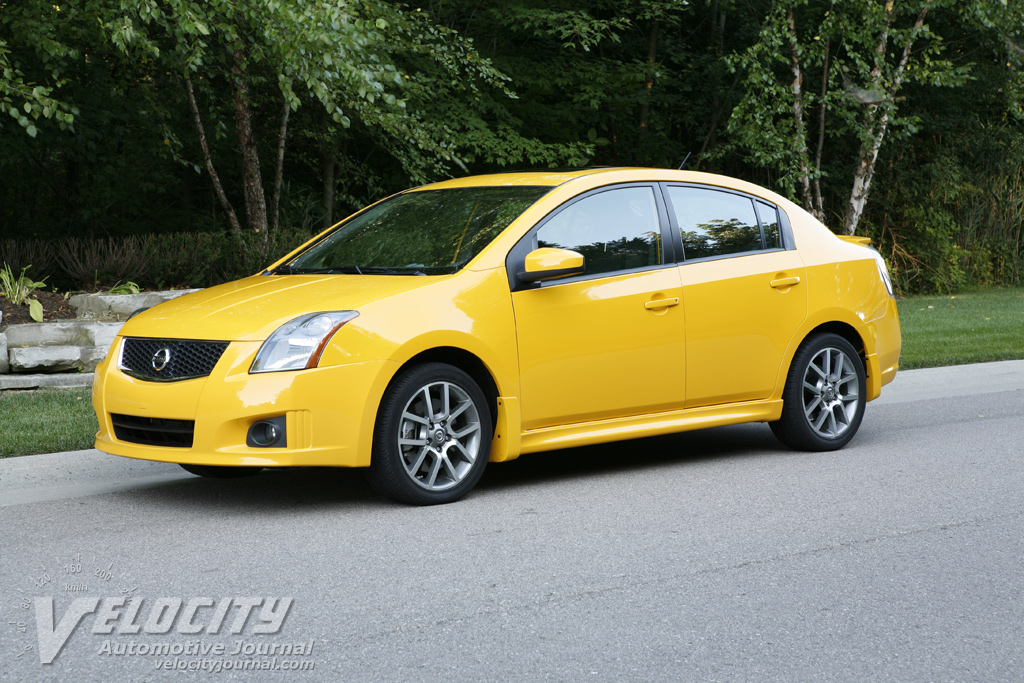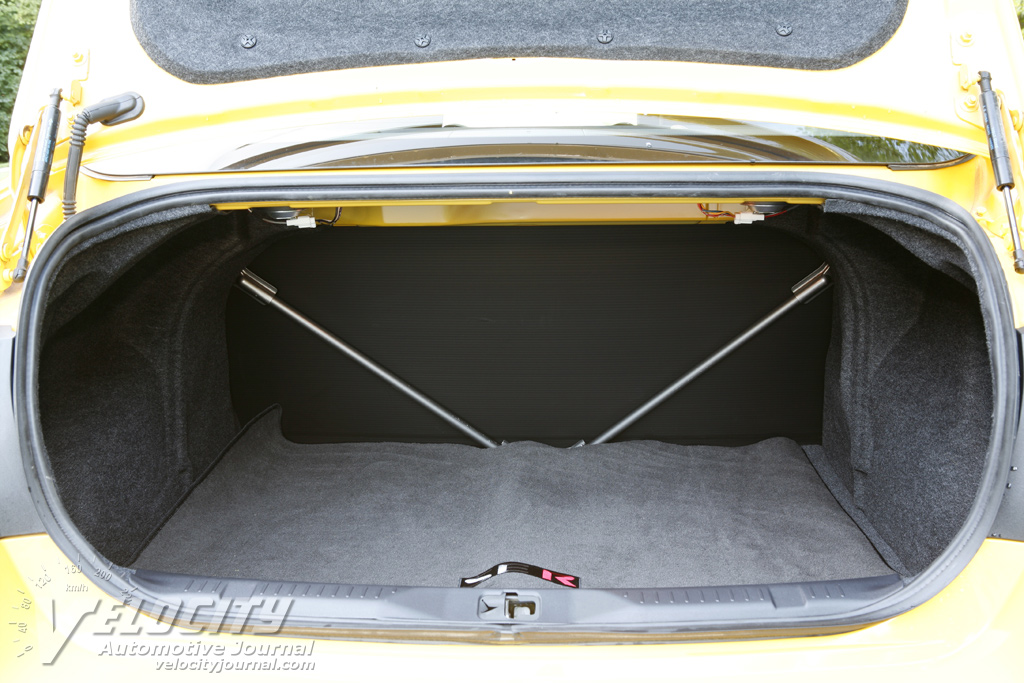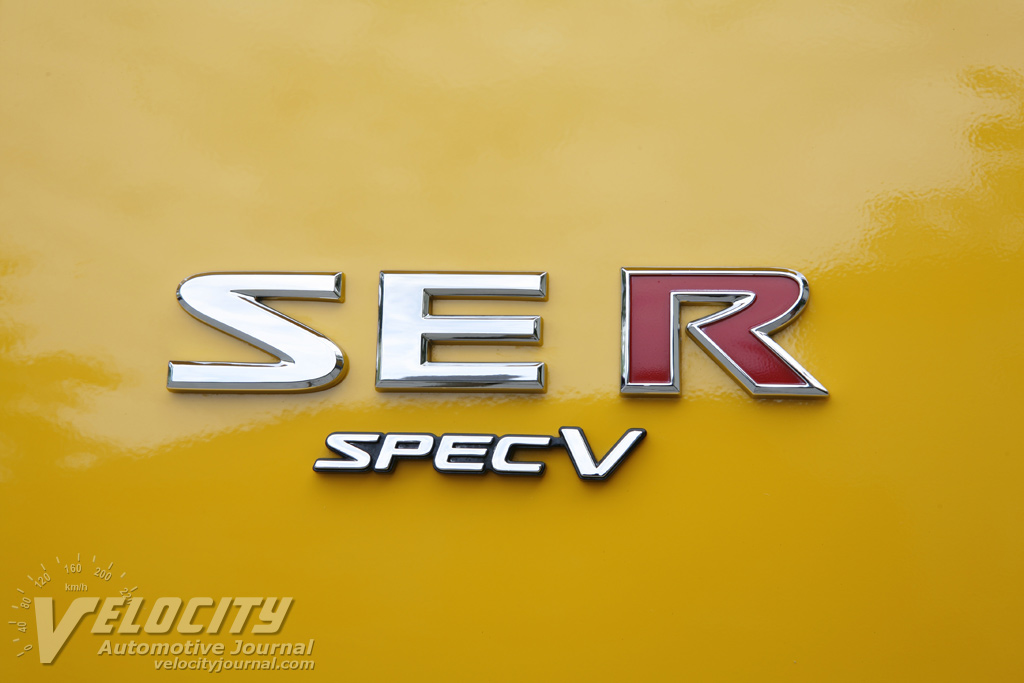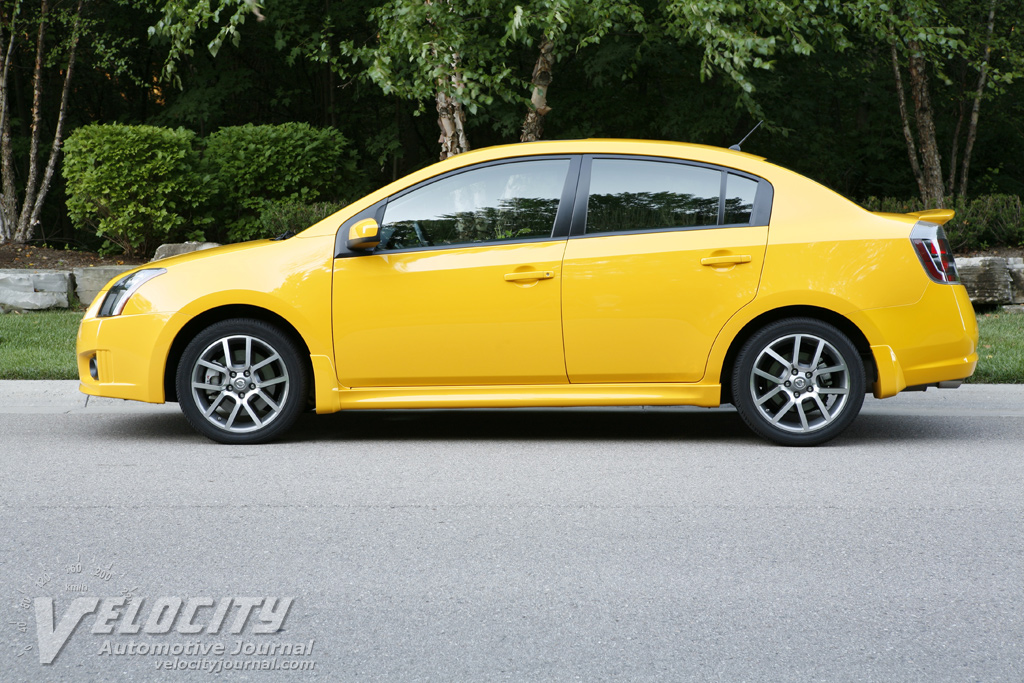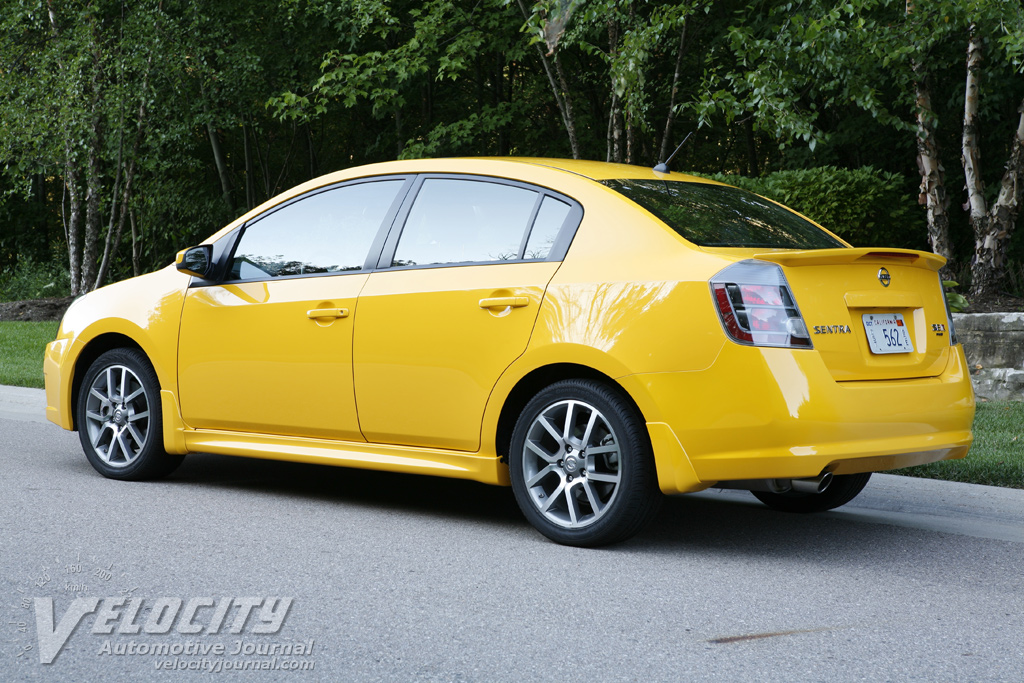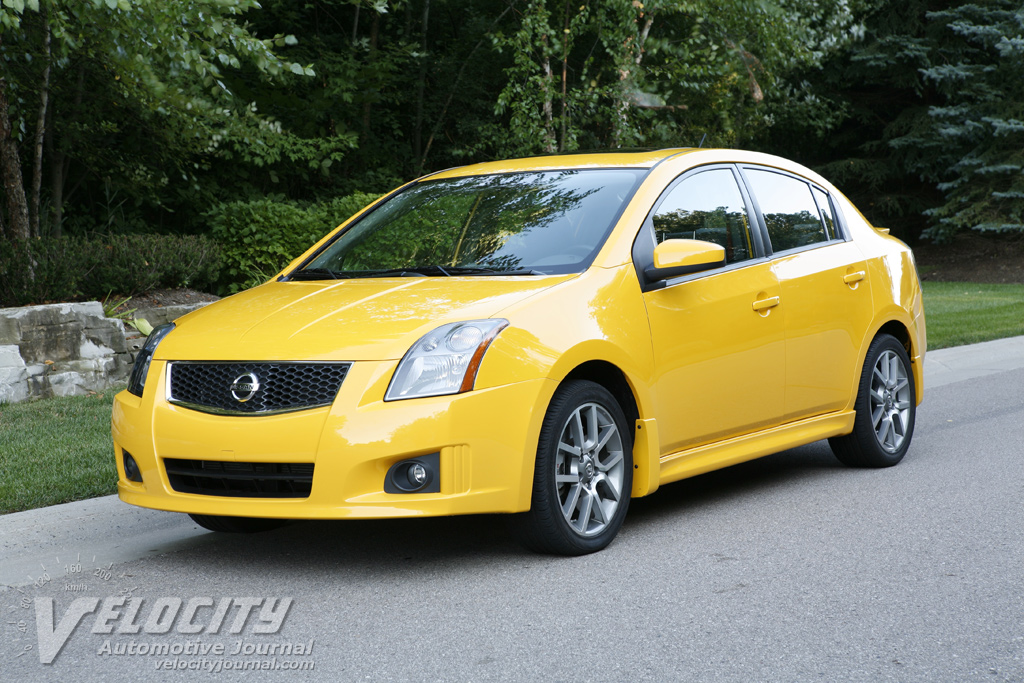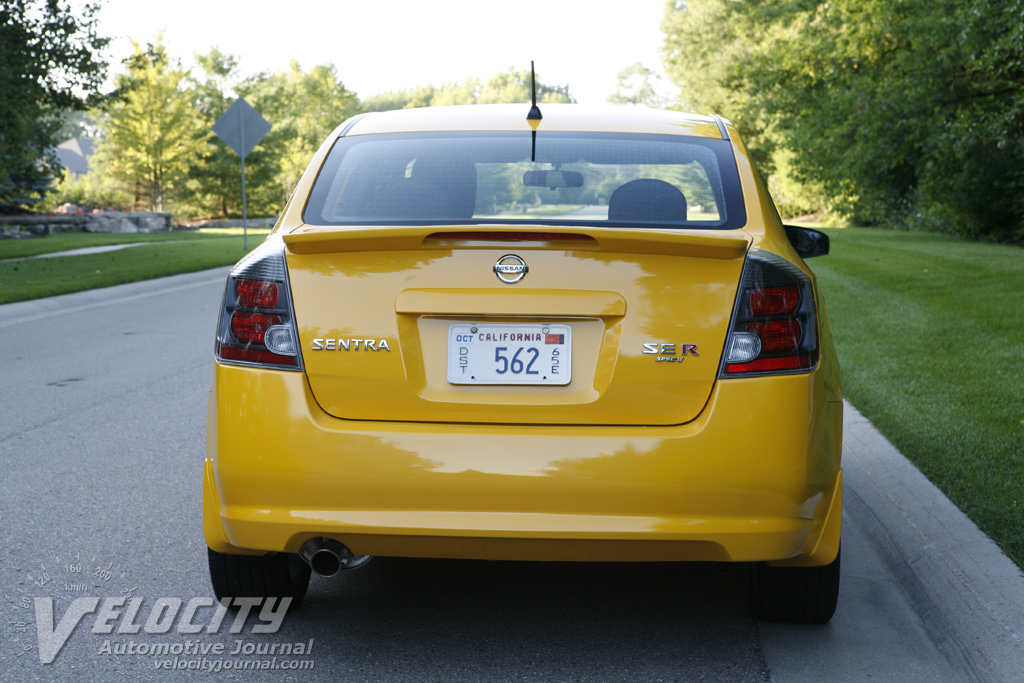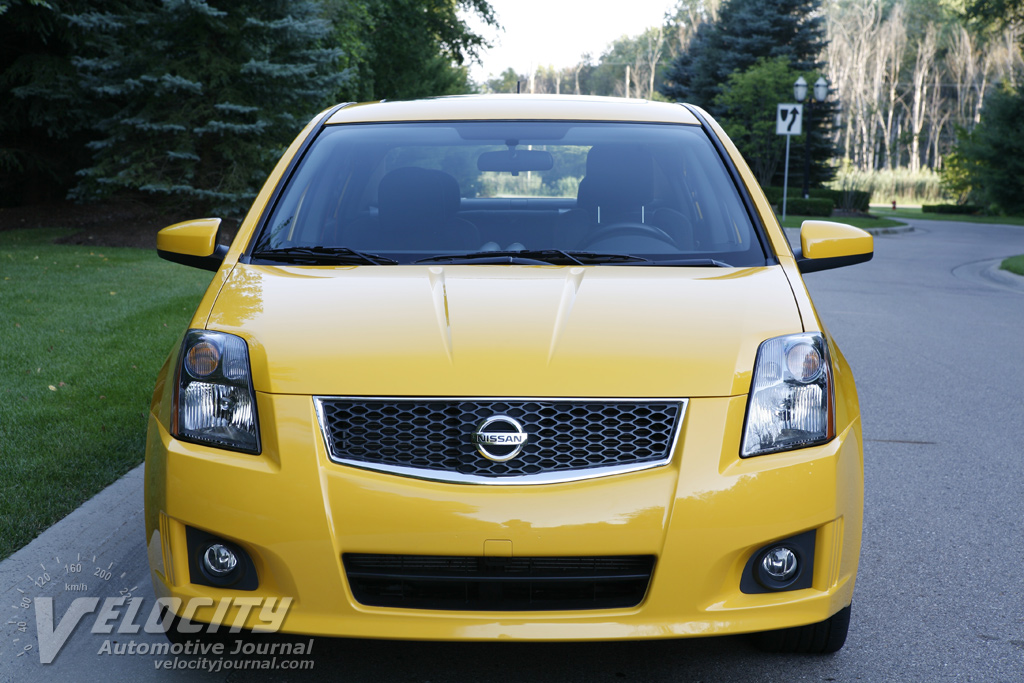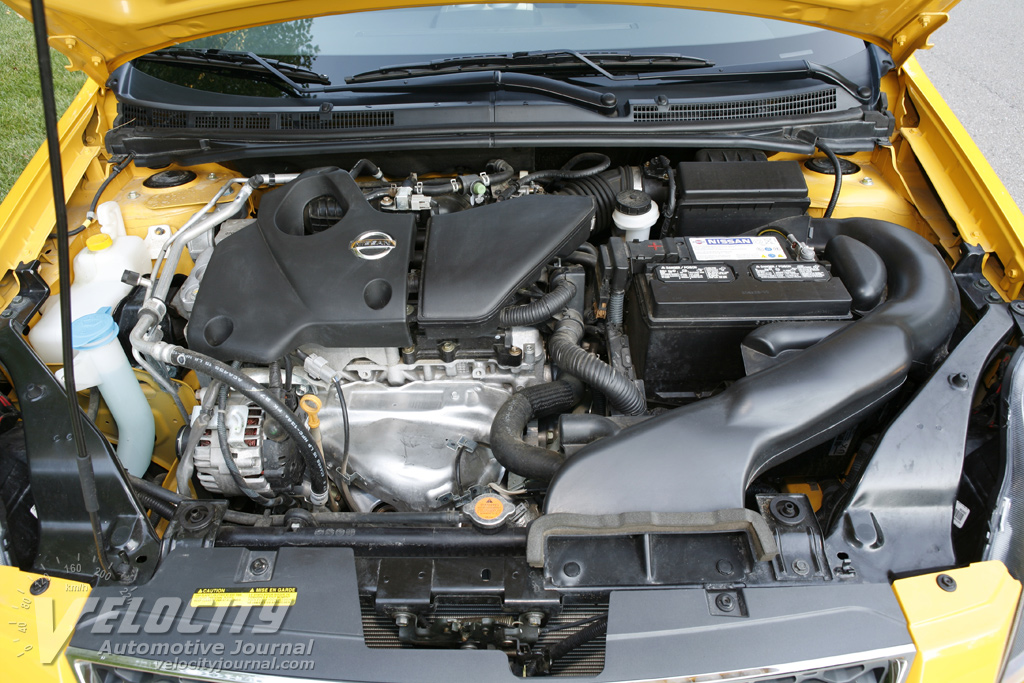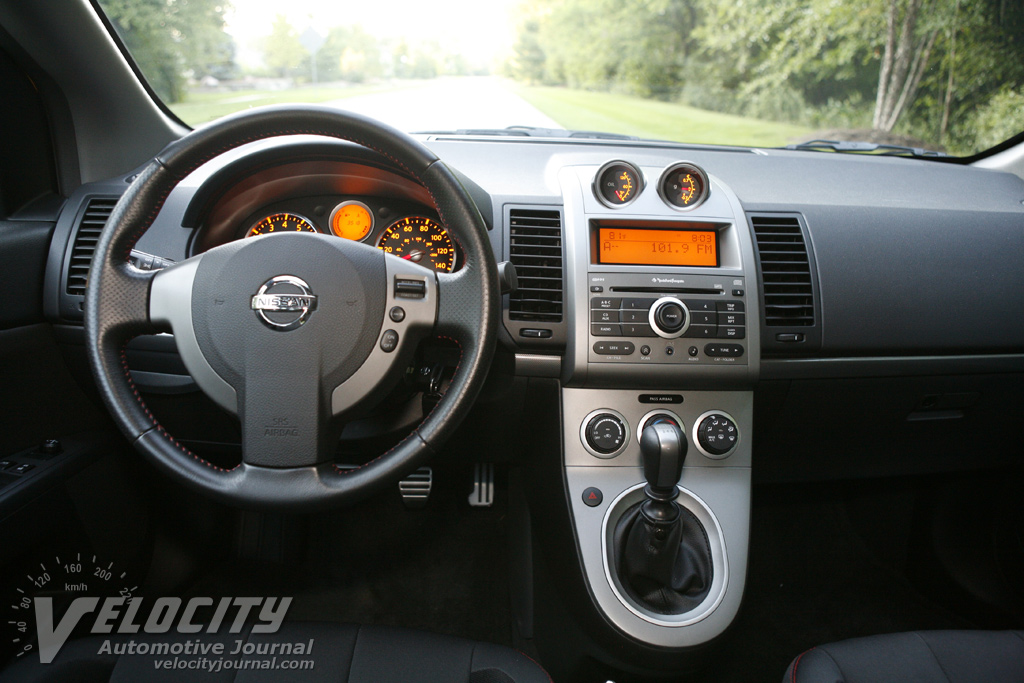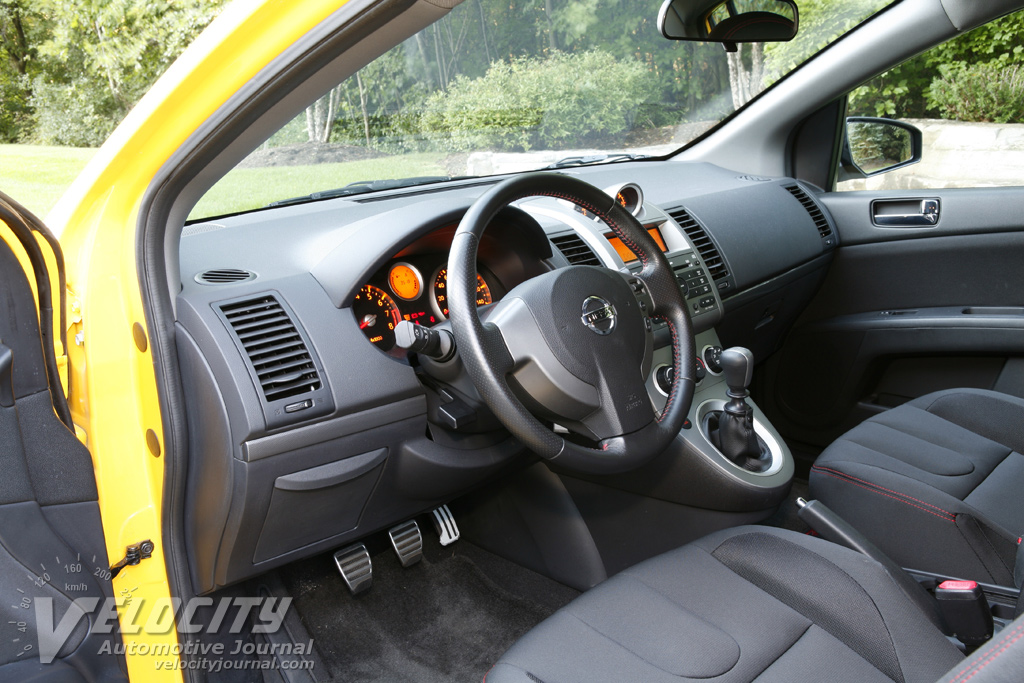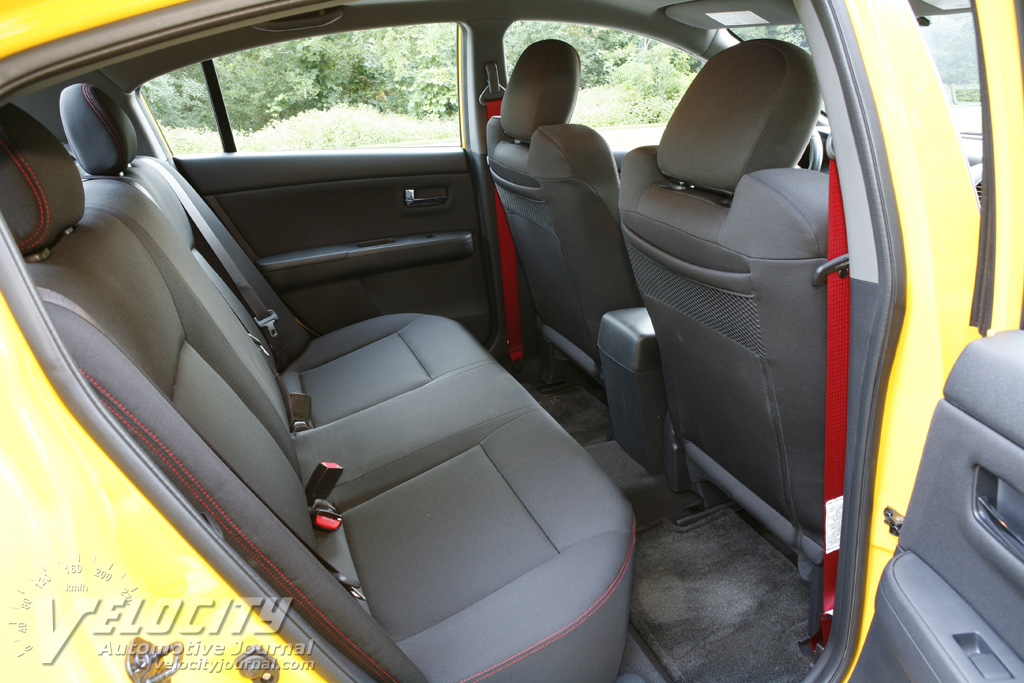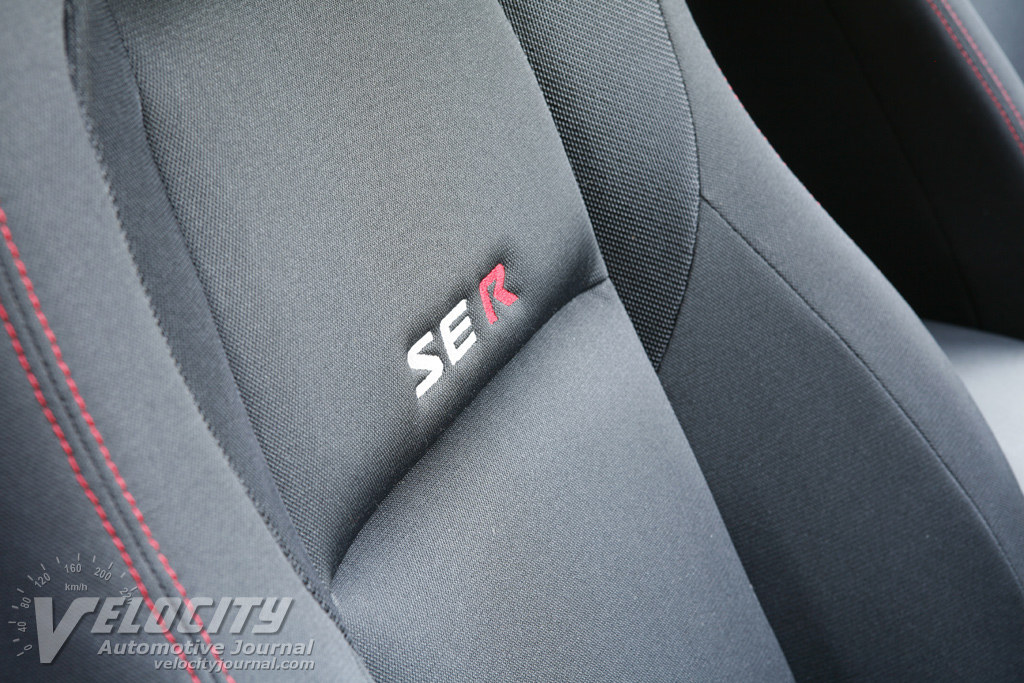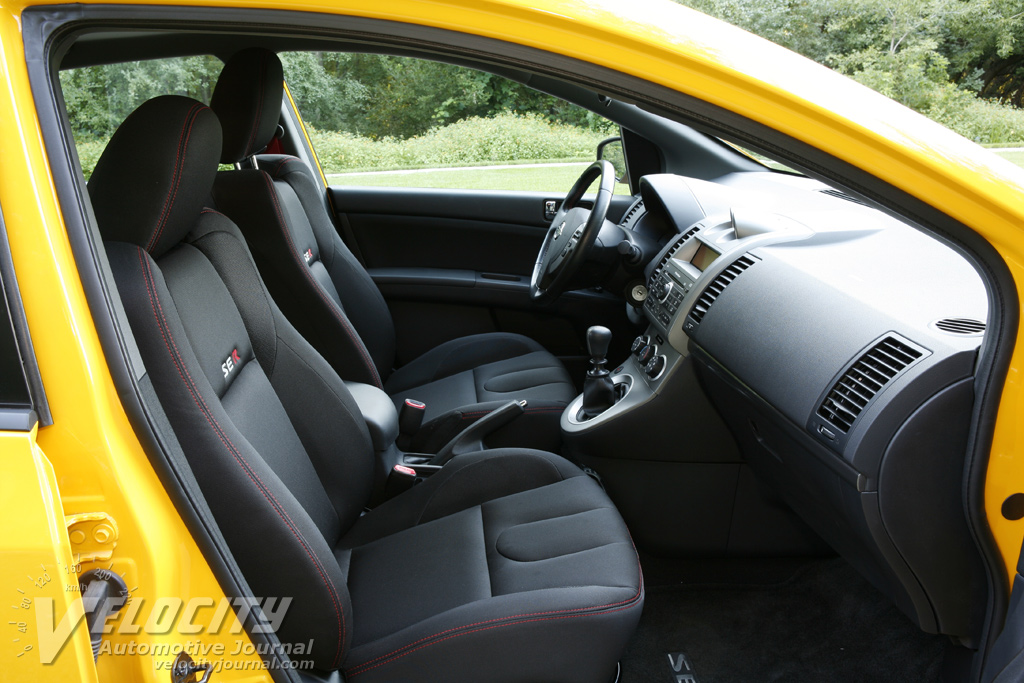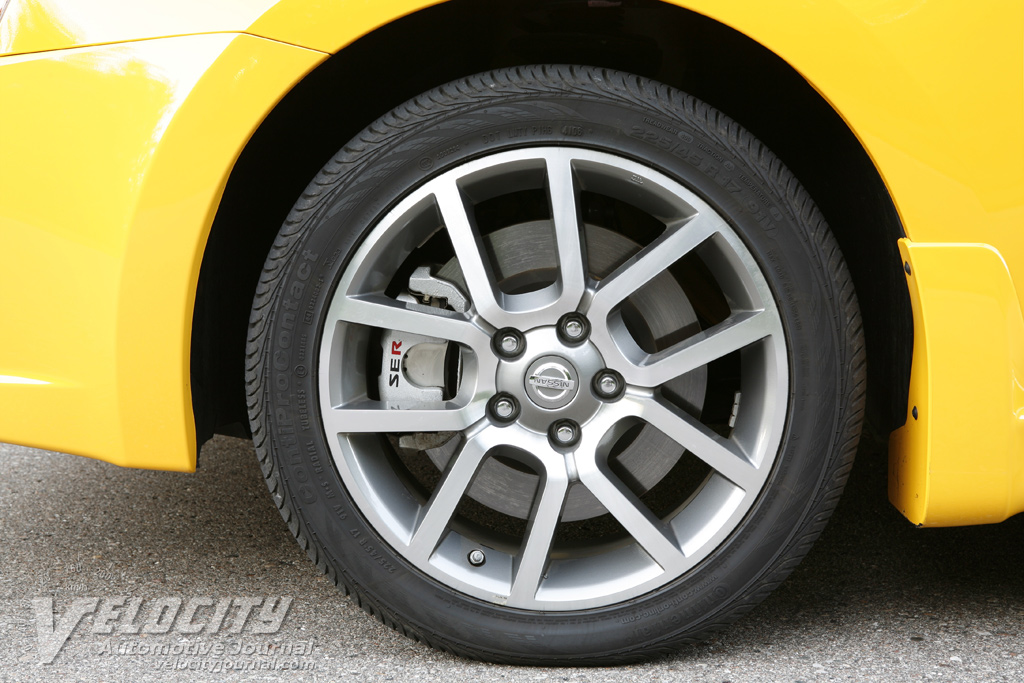2007 Nissan Sentra SE-R Spec V
08/16/2007
Shahed Hussain
Back in 1991, Nissan shoehorned a 2-liter inline-4 into the nondescript Sentra to create the SE-R. Although never as popular as the Civic Si or the Integra among young enthusiasts, the Sentra SE-R has developed a small, but loyal following that continues to this day. The sport compact segment remains a lively arena, with the Caliber SRT4, Civic Si, Cobalt SS Supercharged, Mazdaspeed3, and GTI all vying for enthusiasts, which means that the SE-R has some tough competition to overcome.
As before, the new SE-R is based on the recently introduced Sentra, but instead of the 140-bhp 2.0L MR20DE that powers the normal Sentra, the SE-R gets a 177-bhp 2.5L (200-bhp for the Spec V) all-aluminum DOHC QR25DE engine driving the front wheels. Other upgrades include 4-wheel disc brakes, sport suspension, 17-inch alloy wheels with P225/45WR17 tires, optional helical limited-slip differential (Spec V, with summer performance tires only), and a pair of body-hugging sport seats. While the base SE-R gets a CVT automatic, the Spec V is only available with the 6-speed manual transmission.
We tested a Solar Yellow Sentra SE-R Spec V equipped with the Rockford Fosgate audio system ($750), sunroof ($750), floor and trunk mats ($165), and all-season Continental tires (no cost option). The options and $625 destination charge add $2,290 to the base price of $19,900, for a grand total of $22,190. Note that the 2008 SE-R Spec V starts at $20,180, an increase of $280 over the 2007 model.
Nissan dressed up the interior of the SE-R to separate it from the ordinary Sentra; nonetheless, most trim is of the hard plastic variety. The red-stitched sport seats have SE-R logos embroidered on the seatbacks; aggressive bolsters keep the front occupants snugly in place, but the seat fabric feels slippery. The driver's seat has manual 6-way settings, while the passenger seat has 4-way adjustments; even with their limited adjustability, the seats provide great support. The Spec V gets bright red front seatbelts, which add some color to the predominantly dark gray interior. Front headroom with the optional sunroof is limited: drivers taller than 5'-10" will have to recline the seat to clear the headliner. Rear headroom is likewise limited, but legroom is plentiful. Although the rear seats will accommodate up to three passengers, they are best suited for two occupants.
The SE-R gets a nice fat leather-wrapped steering wheel with cruise control buttons on the right spoke. Both SE-R models get aluminum pedal covers, an unexpected extra. An 8000-RPM tachometer and 140-MPH speedometer are brightly illuminated in amber backlighting; a smaller LCD combines the digital odometer with the bar graph-style fuel and coolant temperature gauges. On the dash above the audio system display are separate gauges for oil temperature and a G-force meter, which only measures forward acceleration and deceleration, not the lateral acceleration one might expect. The 6-speed manual has a high-mounted shifter next to the HVAC controls. Although the unconventional position is slightly disconcerting at first, we quickly adapted to its location, which places the shift lever closer to the driver's right hand. The 12V power outlet hidden under the transmission console is difficult to reach, especially for a radar detector power cord. With its 8-speakers, the optional Rockford Fosgate 340-watt stereo can crank out serious volume. The Rockford Fosgate system includes a 6-CD in-dash changer with MP3 capability, auxiliary audio input, and optional XM® or Sirius® satellite radio.
The Sentra SE-R has always been known for all-around engine flexibility rather than maximum power output. The 180 lb.-ft. of torque from the QR25DE in the SE-R Spec V is impressive, but it arrives at 5,200 RPM, compared with 172 lb.-ft. at a more usable 2,800 RPM in the SE-R. In return, Nissan bumped the Spec V redline to 7,000 RPM, up from 6,200 RPM. The higher redline allows the QR25DE to develop 200-bhp @ 6,600 RPM (on premium fuel) vs. 177-bhp @ 6,000 RPM in the base SE-R. Nissan modified the high output QR25DE in the Spec V with different intake and exhaust manifolds, a 10.5:1 compression ratio (vs. 9.6:1), iridium-tipped spark plugs, different camshaft profiles, strengthened connecting rods, and an 8-counterweight crankshaft. The result of all these upgrades is a smooth, free-revving inline-4 that belies its large displacement. Only the engine shudder after startup and shutdown reveals that there are four big pistons under the hood. Because of its high-RPM tuning bias, the QR25DE lacks the low end grunt one might expect, but instead rewards the driver with a linear powerband up to the 6,200 RPM power peak. Past that point, power flattens considerably; although the boomy inline-4 revs smoothly to the 7,000 RPM redline.
The standard 6-speed manual snicks into each gear, clicking positively between shift gates. A light, progressive clutch ensures that novices will have little difficulty mastering this manual transmission. First through fourth gear ratios are closely spaced, while fifth and sixth are overdrive ratios. A short 4.448:1 final drive ratio contributes to quick initial acceleration. At speeds above 80 MPH, a downshift to 4th gear is often required for best acceleration.
To stiffen up the chassis, the Spec V gets a welded rear "V-brace" behind the rear seat bulkhead. Despite the aggressive sport suspension, the SE-R is handicapped by its overall height (59.1"), which results in considerable body roll, despite the front and rear stabilizer bars. The high center of mass contributes to noticeable brake dive and acceleration squat that results in undesired weight transfer. Even with its relatively long 105.9" wheelbase, the firm suspension causes the Spec V to pitch annoyingly over frost-heaved roads, although on smoother surfaces, the suspension is relatively compliant. Surprisingly, the semi-independent torsion beam rear axle doesn't compromise grip on bumpy roads as much as we expected. The rear end stays planted around cratered curves, even under braking, which is rather impressive. Even though a beam axle suspension is no substitute for a fully independent setup, the Spec V does a remarkable job keeping the rear tires glued to the road. Nissan spent considerable development time tuning the suspension at the Nurburgring Nordschleife track in Germany, and the effort certainly shows.
Torque steer is minimal, aside from some minor hunting at full throttle from a standstill. Understeer in normal driving is minimal, but comes more pronounced at full throttle as the front wheels scrabble for traction. Note that the optional helical limited-slip differential should improve grip. Even though both SE-R models share electrically assisted power steering, we could not distinguish it from a conventional vacuum-assist hydraulic system. Steering is linear and direct, with excellent turn-in response; the SE-R changes direction with remarkable precision, although the top-heavy body prevents the flat cornering stance we prefer. Highway stability is above average, with excellent tracking at speeds up to 100 MPH.
The optional M+S rated P225/45VR17 Continental ContiProContact tires provide above average grip, but are no match for dedicated summer tires. At 80 MPH, the aggressive tread pattern contributes to noticeable tire roar on concrete-surfaced highways. We had a short drive in a Spec V shod with the summer tires earlier this year at Road America, and recommend them for their superior handling. Also, the optional helical limited-slip differential is only available with the standard summer tires. Drivers in the northern US will probably prefer the optional ContiProContact tires for their all-season traction.
Upgraded brakes are included as part of the Spec V package. The standard SE-R gets 11.7" x 0.94" vented front rotors, while the Spec V benefits from larger 12.6" x 1.1" rotors with painted SE-R caliper logos. Rear brakes are 11.5" x 0.35" solid rotors for both models. Four-channel ABS and EBD (Electronic Brake force Distribution) is standard. Although the brakes are initially grabby, the firm pedal inspires confidence at high speeds, and had no trouble slowing down the Spec V from 100+ MPH.
The new Sentra SE-R Spec V is a radically different car than the rather boring standard Sentra. With its 200-bhp engine, 6-speed manual and sport suspension, the Spec V is aimed directly at passionate drivers who need the practicality of a spacious 4-door sedan at a budget-friendly price. Unfortunately, the concessions that Nissan had to make for cost and passenger accommodations in the base Sentra compromise the sporting capabilities of the SE-R. While other competitors such as the Civic Si have a fully independent suspension, the SE-R makes do with a torsion beam axle (albeit superbly tuned). The tall body contributes to excessive body roll that even the sport suspension and stabilizer bars cannot fully mitigate. Ultimately, the basis for the SE-R Spec V should be as a 2-door coupe, like the original SE-R or the later 200SX SE-R. Unfortunately, that slot is taken by the new Altima Coupe, leaving no room for a 2-door SE-R in Nissan's lineup. Even so, the SE-R Spec V is definitely a performance bargain, undercutting all its competitors in pricing, which is quite an achievement in the hotly contested sport compact segment.

